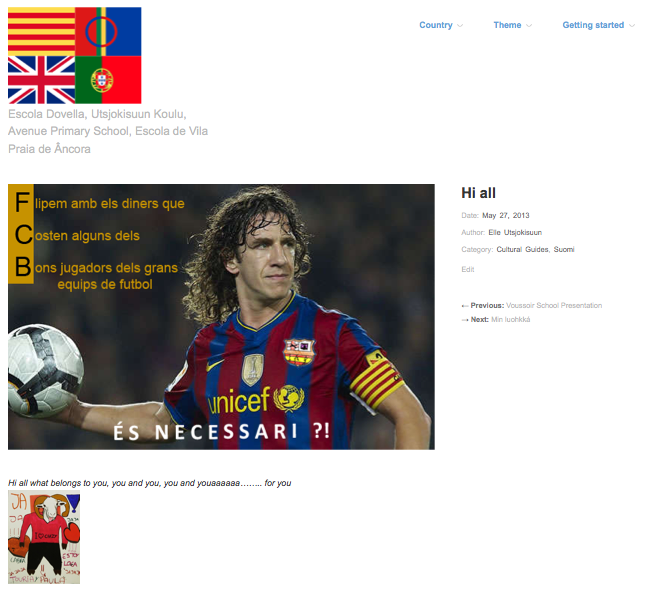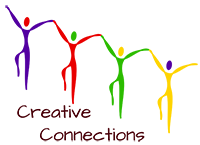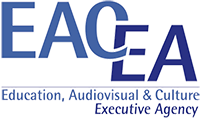Utsjokisuun koulu (primary school) - Finland
Region: Utsjokisuu
Other schools in the Quad Blog: Escola Dovella (Spain), Escola de Vila Praia de Âncora (Portugal), Avenue Primary School (UK)
Creative Connections Project: My Europe and Sami way of life and culture
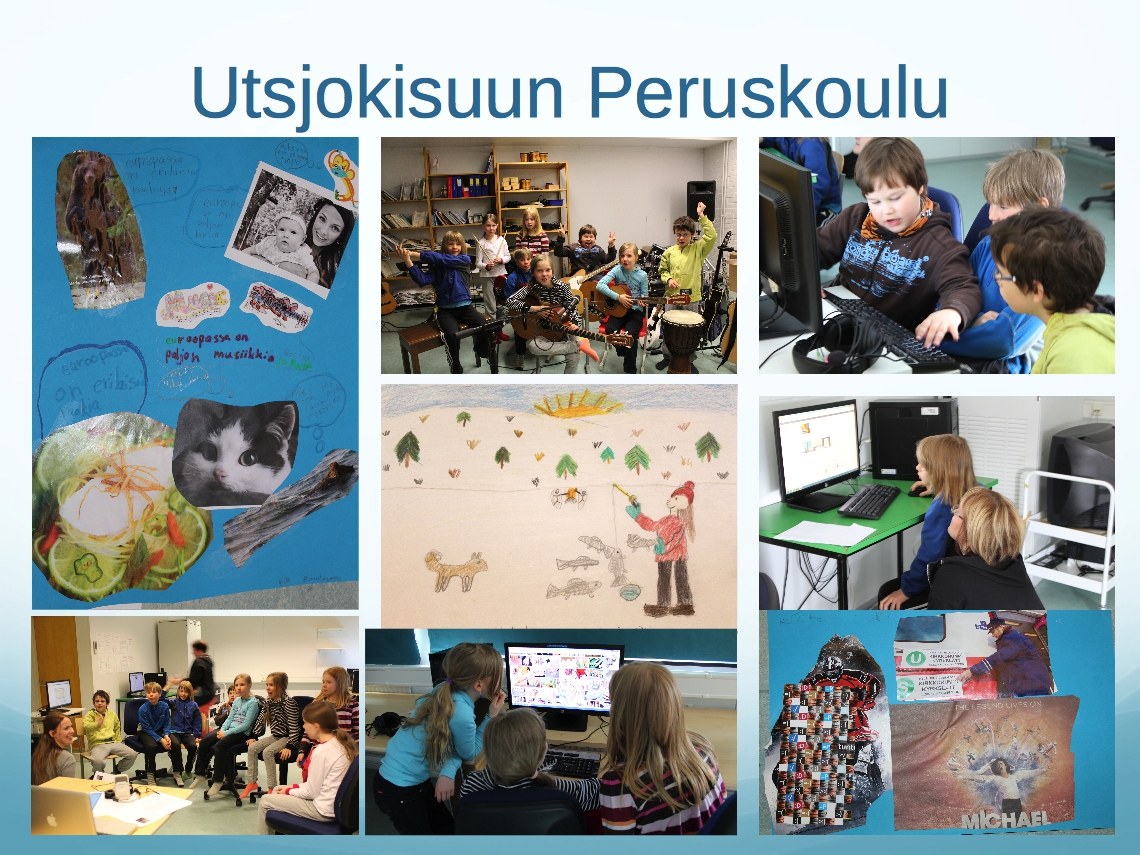
Utsjokisuun koulu, Utsjoki is a rural primary school. The Creative Connections project was carried out with eight pupils in the 2nd and 3rd grade Sami language class, who were 8-10 year old. They participated in the project from April until the end of May 2012.
Utsjoki is located in the northern part of Finnish Lapland, on the shore of the river that marks the border with Norway. Utsjoki is a small community of 1,280 inhabitants, mixing Finnish and Sami speaking people (about half and half). The Utsjokisuun koulu is the elementary part of the school centre in the middle of Utsjoki village. There is the elementary school, upper secondary school, swimming hall and library under the same roof. The school provides teaching in Sami and in Finnish and the classes are divided according to the teaching language.
The school has close co-operation with a Sami school across the border (which is 2km from the school over the bridge). Every Wednesday either the Norwegian or the Finnish pupils are transported in a mini bus and they travel to the other school to have common lessons, workshops or projects. This is possible since Sami is a common language.
Special Issues
Because the teacher worked first with the upper secondary school students for the project, and also due to other circumstances (the school’s headmistress suddenly passed away due to a snowmobile accident), the class started the Creative Connections Project at the end of April. The school year ends in Finland on the 1st of June, so this group had very little time to work with the blog and project, only about a month. The most enthusiastic bloggers from all the Finnish schools were the 9-year-olds from Utsjokisuun koulu, who ‘went wild’ with the charm of blogging. Commenting and posting successfully was exciting for them and the content of the posts were not that important (this showed the children's way of learning things; by playing with the new thing). They also used other images available in the Connected Gallery and were thrilled to see their postings online. They used the blog also in their spare time.
Creative Connections Project: Aims and framework
Since there was only a short period of time, the assignments were short and aimed to introduce the project and themes to the pupils and to introduce the pupils and their culture to the others in the Quad Blog. While the pupils created My Europe collages and discussed the Artworks, the main production was around the presentation of their northern way of life and Sami culture. This was shown in the drawings depicting the pupils’ weekend activities from ice fishing to driving snowmobiles and in the posts of a class photo wearing traditional Sami costumes and playing a traditional song.
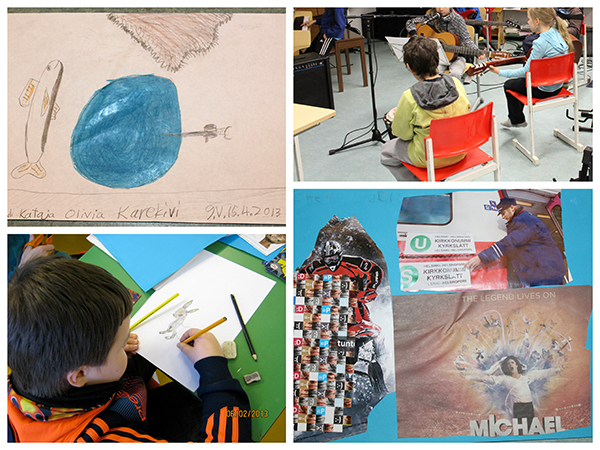
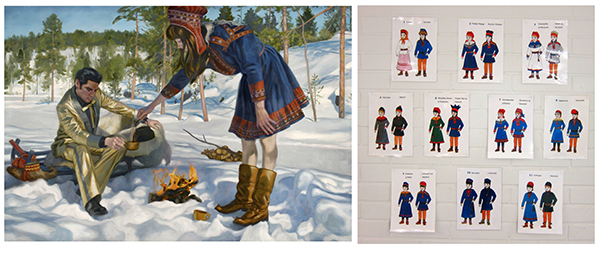
My Europe (images above.)
My weekend drawing was a response to the letter from a Spanish school. All the children told something in response about their town, the school, the class and school day or hobbies. They presented and recorded a traditional song in Sami, and made a group photo and with an audio accompaniment.
The Use of the Connected Gallery
The class explored the Connected Gallery through paper copies of the images. The artworks were spread on tables and the pupils could choose the most interesting ones for discussion. The analysis of the artworks did not advance on producing images themselves. In the interview the teacher stated that she would have liked more concrete instructions in using the artworks with the children. However, she also said that they routinely looked at the artworks together. So they have continued to use artworks in the lessons due to the experience with the Connected Gallery.
After the analysis of the artworks, the pupils were one group who commented on the artwork in the Creative Connections Connected Gallery. The artworks they commented on were mostly Finnish and had some relation to the pupils’ everyday life. Due to the young age of the pupils, the comments are related to concrete things in the images and even to their peers’ reactions to the image. When the children did comment on non Finnish artists’ work they only used remarks such as: ‘nice’ or ‘scary.’
Pupil comment for Markku Laakso’s painting in Connected Gallery
Just calm down there now!!!!
About Identity and European Citizen Themes
In Utsjoki the question of identity was strong and present in everyday life, since the pupils live in a community which deals with identity issues daily. Who is Finnish and who is Sami? Who has the right to be and how it’s demonstrated? On the border there are Sami who are Norwegian, or Swedish or Finnish at the same time. Presenting and showing the local, ethnical and personal identity was important for the pupils in the Creative Connections work.
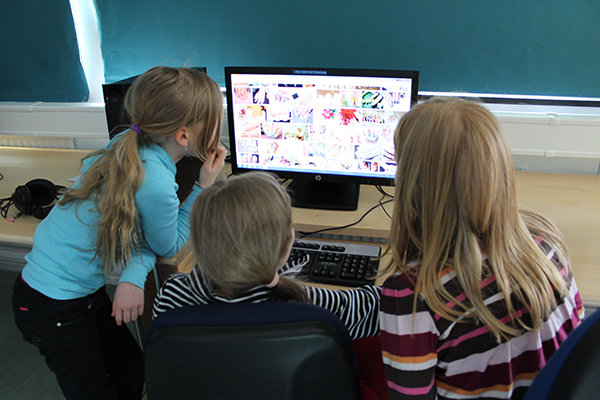
The difference in pupils and students from Utsjoki and the other Finnish participants from Oulu and Rovaniemi, is seen in the selection of artworks analysed. In most of the schools, the pupils/students could choose the artworks that were analysed more closely. The students and pupils from Utsjoki were interested in Markku Laakso’s painting and Outi Pieski’s installation. Both of the artworks have relation to Sami culture and are made by artists from that region. At the same time none of the students or the teachers from other Finnish schools chose these artworks.
The pupils of the Portuguese school in the Quad Blog had made drawings about the tradition of butchering pigs that caught attention in Utsjoki. Concrete things are the best and most comprehensible for these young pupils to discuss what was in the pictures. The topic was interesting to the pupils because of its similarity to the reindeer herding traditions familiar to the pupils and made a great cultural connection to them.
Blogging
Blogging was started when the researchers visited the school at the end of April. Before that the class had discussed about the project and made some drawings and created ‘My Europe’ work. We read the letter that the Spanish class had sent the children in the blog together (translating into Finnish for the pupils). Then we answered the letter and told them about the school, the class, the free time, the lessons and studying.
The blogging was started in a computer class and the pupils wrote short letters in Finnish (not their mother tongue, since this was a Sami class). Some pupils worked in pairs, some individually. The pupils were excited to get to use the internet and computers in the school and they were already commenting on the Spanish pupils’ drawings in the blog, before we instructed them in doing their own postings.
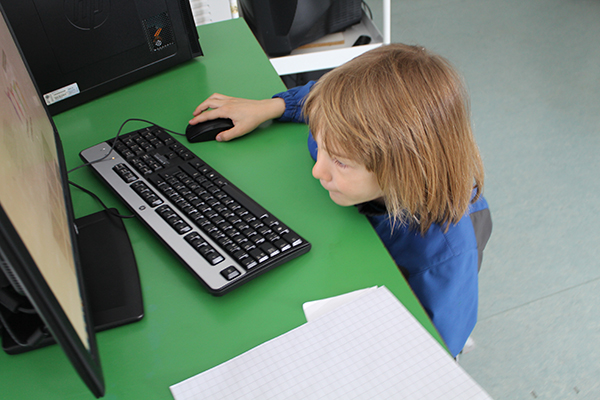
These pupils were the most excited about using the blog. They had not used computers or internet in school much and according to the teacher this explained their enthusiasm. They have also used the blog in their own time at home and made their own postings without assignment, instructions or relation to schoolwork.
Teacher comment
Well my class is like that, if they just get to the computers, it’s a nice thing. But we have used computers really little, so I started the computers and opened the website for them.
In spite of all the other students and teachers complaints of the illogical function and usage of the blog, the 9-year-olds did not mention that it was hard or complicated. Probably their motivation made the problems feel smaller or they simply did not have anything to compare with the blogging system and expected it to need some learning and practicing as all new things.
The pupils’ language skills were not on the level to write in English, so this class was the only Finnish group actually using the web translator both to understand others’ postings and to translate their Finnish texts. Pupils ended up playing with the translator and amusing themselves with the quality of Finnish translations.
Teacher comment
When you chose that translation in Finnish, it gave such funny texts, they got so excited that they started to look at how it translates everything. Then they started to imitate the translator's Finnish on their comments to the images. So I had to forbid them to use that kind of language since it’s not proper Finnish. It was a really funny thing for them. And even the boys of the upper secondary group got enthusiastic to do that and started to write using ‘Google Translator Finnish.
Reflection
The experiences from the Finnish schools have shown the speciality of Sami culture effects on Utsjoki. From their point of view, since the majority of Finnish culture and population does not represent their ethnic identity, the importance of including regional artworks and artists to the Connected Gallery became meaningful. Also the different relation to identity and how it is represented in the everyday life was strongly evident from their approach to this European project and their work.
Teacher comment
They are very conscious who they are and what is their identity. On the other hand they think that all the Europeans think that the Sami people live in huts and that there are polar bears here and everything, so they want to straighten those beliefs.
The young pupils surprised the teacher and researchers by being the most motivated and excited bloggers of all the Finnish schools, also they did not report any difficulties or technical issues with the blog. The teacher also said that they were able to access the Connected Gallery without problems, unlike the upper secondary students. Probably the technical problems were solved at that time, since the secondary students were the first to start blogging and the primary class one of the last ones. The excitement of using the internet, publishing in blogs and being in the images, was more important than the content of the postings.
